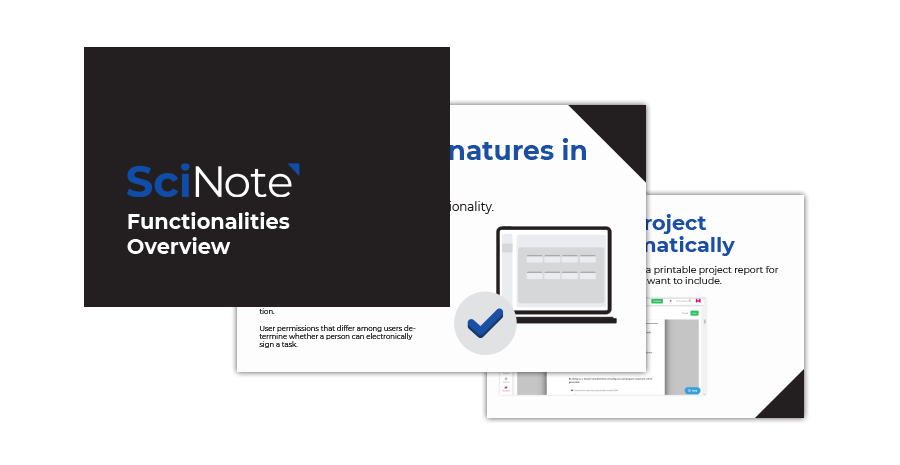Switching from Paper to Electronic Lab Notebook – Top barriers and solutions [Research]
![]() 3 min read
3 min read
Labs expressed their opinion in the recently published study “Electronic lab notebooks: can they replace paper?” that addresses the subject of switching from paper to an ELN (Electronic lab notebook). Here, we summarize key barriers to faster ELN adoption and solutions on how to tackle them, according to the findings.
Paper laboratory journals and notebooks are no longer the most efficient way to keep research records. This is mostly due to the increasing amounts of digital data generated in labs today.
Experimental data analysis often relies on digital tools and there is a growing need in many labs to implement an easy to use lab management system.
However, the adoption of digital systems in labs has been slow. In order to gain better understanding of the situation, we decided to conduct the largest study on ELN adoption so far. The study provides information on the direction in which the ELN market is moving and insight on why the ELN adoption has been so slow.
Barrier 1 of switching from paper to an ELN – Price and budget
When talking about ELN costs and limited budgets, a large percentage of survey respondents indicated that cost was a significant barrier to ELN adoption. This includes financial outlay, staff hours, troubleshooting, and the fact that long-term use is likely to require on-going maintenance and support.
Besides that, academic institutions tend to think about the long term, so they need a solution for which they are sure that there will be no sharp changes in costs, once they establish the system within their institution.
Solution – Permanently free accounts
For academic labs with limited budgets, the study describes a couple of solutions. Even though most ELNs available on the market today are proprietary, open source and free ELNs are becoming more common.
It is important to distinguish here between free trials or demo versions of some ELNs, and ELNs that offer free accounts with full functionality and claim that free accounts will not be charged for in the future. It is advisable to go through these details with the ELN team before implementing an ELN in your lab, because, as previously mentioned, you want to avoid any unnecessary costs that might affect your institution’s budget too much in the future.
Do not confuse the term open source with access to your data. Researchers who decide to upgrade or change the source code of an open source software will do that for themselves and choose if they want to make the improvements available to the rest of the scientific community or not. But they cannot access your data. As well as you cannot access theirs.
Barrier 2 – Ease of use and complexity
The greatest concerns arise when labs start considering the implementation of the new electronic system into their everyday processes. Whether an ELN would be used by one individual or an entire team, it is important to address the complexity of the system, the learning curve of the users in the lab and the resources needed.
In the study, respondents were asked about how important the ease of use is for them (if they are to switch from paper to digital for example). 99% of respondents indicated that “ease of use would influence their ELN choice, with almost 80% rating it as very important. One comment reflected the desire for a flexible generic solution, rather than an ELN designed for a specific research area, due to anxieties that their research “doesn’t fit neatly into one category”.
Solution – Flexible and intuitive software
The process of scientific exploration and discovery is often unpredictable and not entirely linear, so an ELN would need to provide the flexibility to researchers to use it as best fits their needs. Besides flexibility, design and user experience of the software play the major role in reducing the time needed for the users to understand the software and actively use it on a daily basis.
On the other hand, it is necessary that when switching from paper to an ELN the chosen software provides more lab-oriented functionalities than the generally used note keeping applications such as Evernote, OneNote and similar. For example, the ability for the user to manage inventories, defining protocols and experiments, linking samples with results etc.
Barrier 3 – Scattered data
The studies detailed in this paper indicated worries about the ability to find, move and access data between different ELNs and lab instruments; and whether this would result in data duplication.
The study shows that among the respondents “74% expressed concerns about needing to enter data in both the lab and write-up area, due to a lack of suitable hardware or software capabilities to facilitate ELN usage inside and outside the lab. This can lead to copying and pasting printouts into paper notebooks and manually transcribing data between notebooks and computers; which can result in data loss, transcription errors and records stored haphazardly. Popular suggestions were to use mobile computers or tablets for portability in and out of the lab, and that web-based ELNs could improve accessibility.”
Solution – All in one place
It is important that an ELN supports all types of data that can be easily saved, accessed and annotated. Keeping everything in one place, from pictures to excel sheets, has major benefits when searching for data or reporting on a project. It is already becoming impossible to keep track of it all in paper notebooks.
The authors conclude that “ELNs will significantly improve reproducibility of scientific experiments, contribute to the data traceability and data annotation and enable scientists to collaborate and share results in an intuitive manner. The wider adoption of ELNs will facilitate interoperability which will ultimately change the ways scientists perform experiments and manage their data.”
Switching from paper to an ELN doesn’t have to be complicated.
Get your free comprehensive guide of all SciNote’s functionalities and see how you could benefit from an ELN.
Conclusion
The study focused on researchers’ current practices, their opinion towards ELNs, and their desired functionalities i.e. main priorities of different ELN features, ranging from whether respondents saw them as not important to very important. We explored and summarized the barriers to adoption within academic environments.
We can conclude that ELNs are a suitable replacement for paper notebooks. Following these findings, we defined the priorities for future ELN development and developed SciNote Electronic Lab Notebook.
SciNote is a top-rated platform for researchers in academia and industry, who need
electronic lab notebook, inventory management, and project management functionalities.
To see which SciNote plan would best fit your lab’s needs, visit: SciNote Free and Premium Academia or Industry plans.



